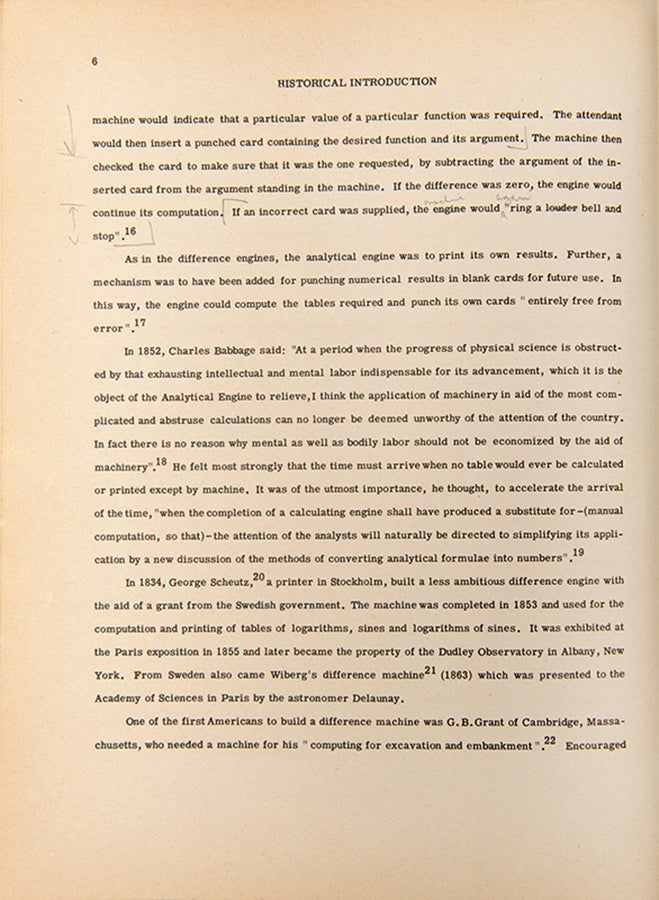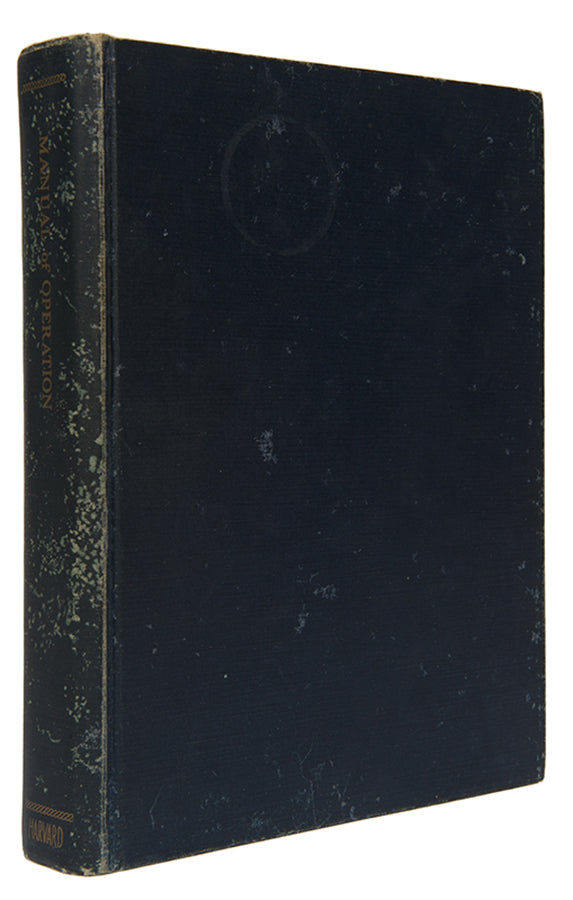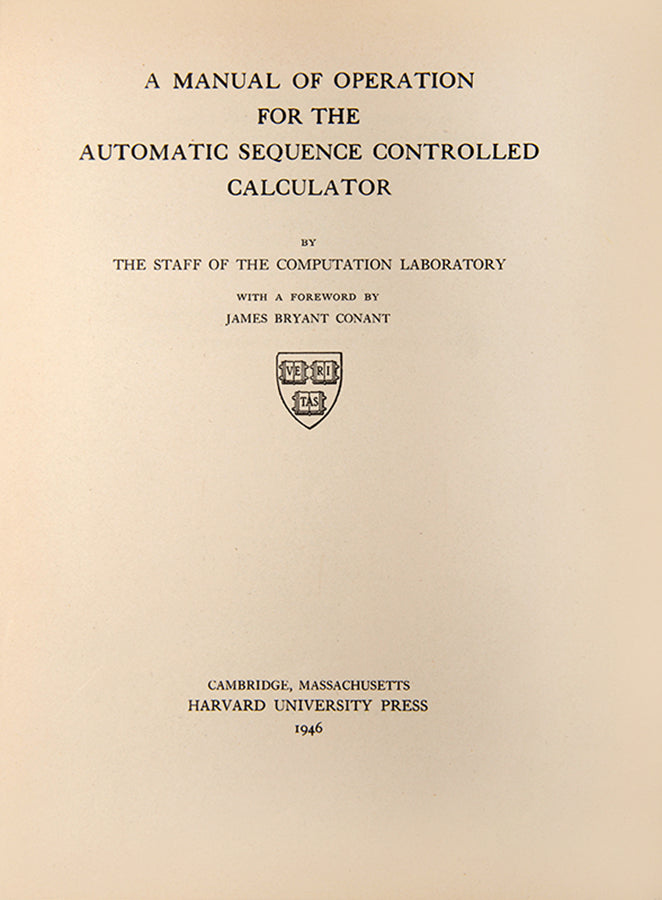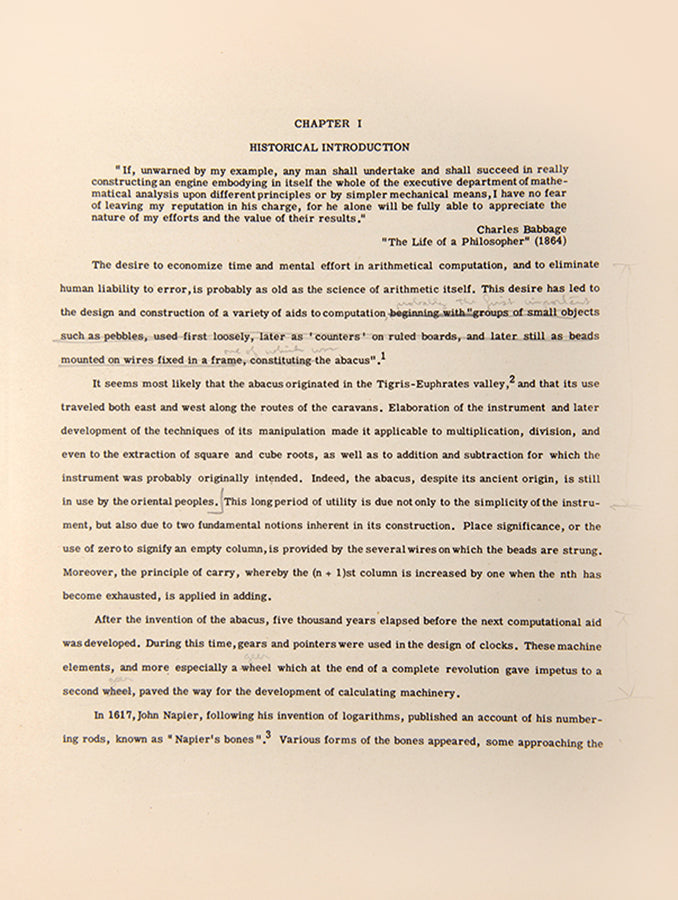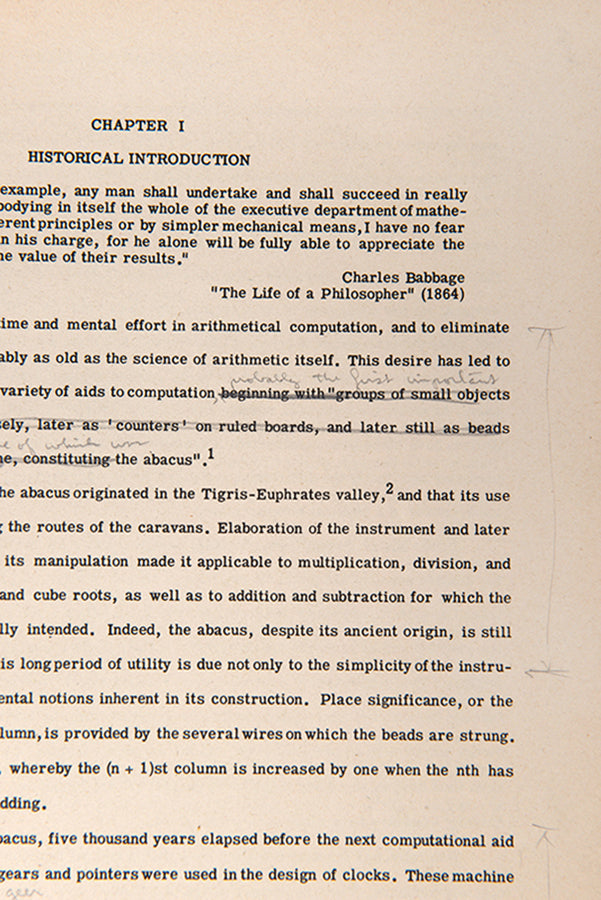HOPPER, Grace Murray; AIKEN, Howard.
A Manual of Operation for the Automatic Sequence Controlled Calculator.
A Manual of Operation for the Automatic Sequence Controlled Calculator.
Stock Code 113917
Cambridge, MA, Harvard University Press, 1946
Interestingly, the present copy contains pencilled editorial notes in chapter 1, typically shortening and simplifying sentences as if for a new edition or perhaps a separate publication or talk. Though at first glance the hand looks similar to Hopper's, careful comparison with a technical manuscript produced during the same period does not seem to indicate a match ('Formulas and coding for problem G on the Mark I', Grace Murray Hopper Collection, Smithsonian National Museum of American History). The corrections also do not match the final text of Aiken and Hopper's article on the Mark I in Electrical Engineering 65, also published in 1946. Additionally, there are calculations on a scrap of lined paper loosely inserted between pages 292 and 293, but these not not match her hand, either. We have been unable to locate sufficient examples of Aiken's handwriting to determine whether he was the editor.
The Mark I was first proposed in 1937 by Harvard professor of applied mathematics Howard Aiken (1900-1973), whose background was in both electrical engineering and physics, and who hoped to use electronic calculating machines to solve complex scientific problems. Initially designated the Automatic Sequence Controlled Calculator, it was funded by the U.S. Navy and IBM, built by IBM at Endicott, New York, and delivered to Harvard in early 1944. The Mark I was used immediately by the Manhattan Project's John von Neumann to make calculations related to the implosion of the first atomic bomb.
Grace Murray Hopper came to the project as a naval reservist after earning her PhD in mathematics at Yale and teaching at Vassar for thirteen years. She was one of the first three programmers of the Mark I and made enormous contributions to the project, for which she received the Naval Ordnance Development Award (Mitchell, The Contributions of Grace Murray Hopper, University of North Texas PhD Dissertation, 1994). 'In 1946 Aiken and Grace Hopper published A Manual of Operation for the Automatic Sequence Controlled Calculator. The instruction sequences scattered throughout this volume on the Harvard Mark I were among the earliest published examples of digital computer programs. Aiken saw himself as Babbage's intellectual successor, and in an excellent historical introduction to this technical manual he and Hopper placed the Harvard Mark I in its historical context' (Hook & Norman).
'[The Harvard Mark I] manual was a milepost that marked the state of the art of machine computation at one of its critical places: where, for the first time, machines could automatically evaluate arbitrary sequences of arithmetic operations. Most of this volume (pp. 98-337, 406-557) consists of descriptions of the Mark I's components, its architecture, and operational codes for directing it to solve typical problems.... The Manual is one of the first places where sequences of arithmetic operations for the solution of numeric problems by machine were explicitly spelled out. It is furthermore the first extended analysis of what is now known as computer programming since Charles Babbage's and Lady Lovelace's writings a century earlier. The instruction sequences, which one finds scattered throughout this volume, are thus among the earliest examples anywhere of digital computer programs' (Ceruzzi 1985, xv-xvii).
The Mark I was obsolete almost as soon as it was delivered, and Aiken and his team would go on to design and build three additional machines. He 'directed research in switching theory, data processing, and computing components and circuits' and 'initiated one of the earliest graduate programs in computer science at Harvard University: fifteen doctoral degrees and many master's degrees were earned under his supervision... Scientists across the world were welcomed into his laboratory, and he did much to stimulate interest in computers in Europe' (IEEE Computer Society biography).
Hopper remained at Harvard through 1949 to work on the Mark II and III, but had to leave when her three-year term as research fellow ended because permanent positions were not available to women. She joined the Eckert-Mauchly Computer Corporation as a senior mathematician on the development of the UNIVAC I and II. It was there that she 'pioneered the idea of automatic programming and explored new ways to use the computer to code. In 1952 Hopper developed the first compiler called A-0, which translated mathematical code into machine-readable code—an important step toward creating modern programming languages' (Biography, Office of the President of Yale University). Beginning in the early 1950s she pushed for language-based programming, which at the time was believed to be infeasible. Her creation of a word-based compiler and programming language, FLOW-MATIC, made computers more accessible, and in 1959 she was a leading participant in the development of COBOL, the Common Business-Oriented Language that could be used across industries. 'By the 1970s, COBOL was the "most extensively used computer language" in the world' (Yale).
Hopper is one of the most recognised women in the history of science and technology. In addition to more than forty honorary degrees, she was the first woman to receive the National Medal of Technology as an individual; the first woman and first American to become a Distinguished Fellow of the British Computer Society; and was posthumously awarded the National Medal of Freedom, the highest civilian award in the United States.
First edition; 4to; 9 plates from photographs of which 8 are double-sided, pencilled editorial notes to chapter 1, light tanning from a loose partial sheet of equations inserted between pages 292 and 293, contents faintly toned; original blue cloth, title to spine gilt, cloth rubbed and marked with scattered loss of size, particularly along the spine, faint ring mark to the upper board, small worn areas at the extremities, very good condition; 561pp.
Hook & Norman (Origins of Cyberspace), 411.
Couldn't load pickup availability
Provenance
Provenance
Delivery
Delivery
We offer secure and express delivery on all local and international orders of rare books, maps and prints placed through this website.
About us
About us
Shapero Rare Books is an internationally renowned dealer in antiquarian & rare books and works on paper.
Our Bookshop and Gallery can be found in the heart of Mayfair at 94 New Bond Street, where most of our stock is available to view and on public display.
We exhibit at major international art fairs, including TEFAF (Maastricht and New York), Frieze Masters, Art Miami and Masterpiece London, as well as antiquarian & rare book fairs including New York, Paris, London, Los Angeles, San Francisco and Hong Kong.
Ask us a question
Ask us a question
